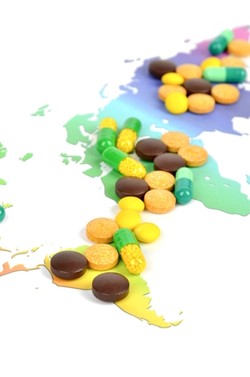Study backs organised crime links to counterfeit medicines
Phil Taylor, 18-Jan-2015
 A study of counterfeits of a single medicine brand has found similarities that suggest one organised, criminal organisation is likely behind the trade.
A study of counterfeits of a single medicine brand has found similarities that suggest one organised, criminal organisation is likely behind the trade.
That is the conclusion drawn by scientists from pharma company Roche and the Institute of Forensic Science in Switzerland, who systematically profiled samples of the unnamed capsule product taken from 33 separate seizures around the world between 2004 and 2013.
Armed with high-tech analytical technologies that can identify counterfeits both in the field and - for confirmation - in the lab, the pharma industry is now trying to harness the data from these analyses to provide "forensic intelligence" into the nature of the criminal activity, and how to fight it.
This profiling approach "is still in its infancy", the researchers write in the journal Forensic Science International (March 2015 edition), but the pharma industry could learn a lot from the way this approach is implemented by agencies tackling the trade in narcotics.
The team analysed the chemical composition of the counterfeits - along with their packaging - which were discovered in a number of different distribution channels.
From the data they hoped to provide some indication of whether the fakes were made by a single producer - which would point to a large criminal group operating at an industrial scale, or from different sources which would indicate a fragmented, less organised network.
The counterfeit capsules were screened using techniques such as near infrared (NIR) and Raman spectroscopy, followed by chemical testing in the lab, while the packaging was assessed using visual comparison with genuine products.
Other intelligence data such as the date and country of seizure, amount of fake product seized and the seizure type - online, pharmacy, or in-transit - was also taken into consideration.
"Material information gathered from seizures constitutes the only tangible trace of the illicit action," say they authors, led by Klara Dégardin, a counterfeit analysis expert at Roche.
Furthermore, traditional ways of investigating this type of crime have failed to solve the problem as the counterfeiting persisted over several years, they add, and the data gathered via this process "may not be sufficient for Court, but [is] amply sufficient for intelligence-led action."
The results of the analyses "favour the hypothesis of one single main network dominating the market" for this particular counterfeit, with production carried out at industrial scale, they conclude
Image via Shutterstock / anaken2012
Related articles:



©
SecuringIndustry.com
 | back to top
| back to top




 A study of counterfeits of a single medicine brand has found similarities that suggest one organised, criminal organisation is likely behind the trade.
A study of counterfeits of a single medicine brand has found similarities that suggest one organised, criminal organisation is likely behind the trade.
